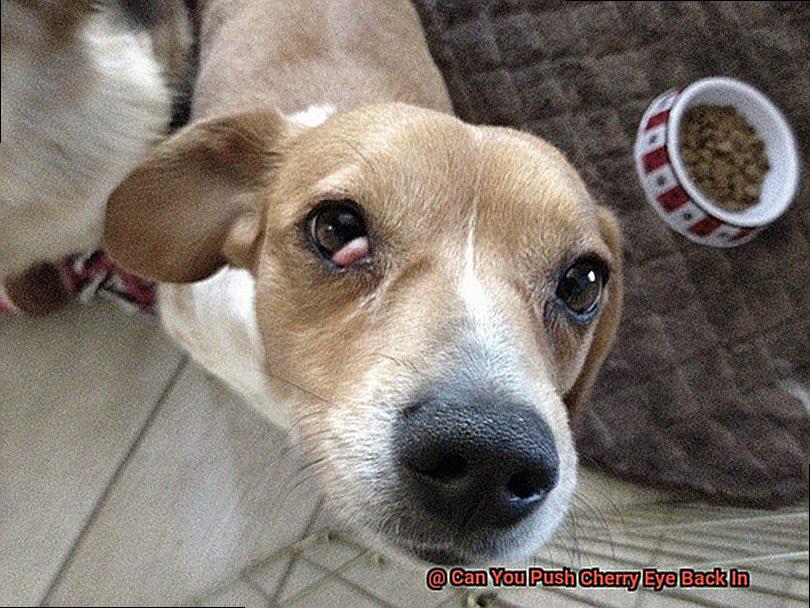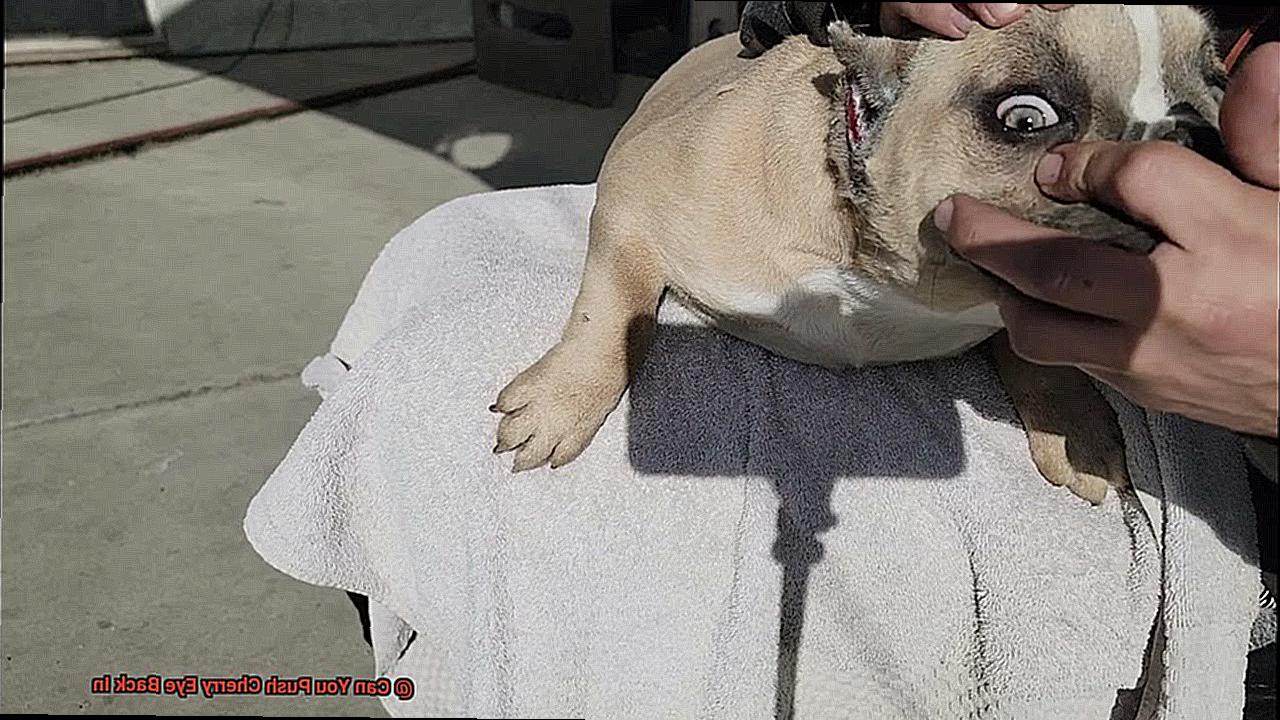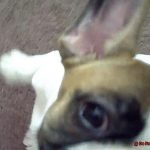Can You Push Cherry Eye Back In?
Picture this: you’re snuggling with your four-legged companion when you notice a strange, bulging redness in the corner of their eye. Cue the panic. But fear not, my fellow pet parents, because what you may be dealing with is a case of cherry eye – a common condition that affects dogs around the world. And let me tell you, there’s no need to hit the panic button just yet.
Cherry eye occurs when a gland in your pup’s third eyelid pops out, causing that alarming red swelling and maybe even some teariness. Now, I know what you’re thinking – can you actually push cherry eye back in? Well, today we’re diving deep into the fascinating world of cherry eye to debunk myths, explore treatment options, and guide you on whether or not it’s safe to give that little protrusion a gentle nudge.
So if you’re a concerned fur parent seeking answers and solutions for your furry friend’s comfort, keep reading. We’ve got all the juicy details on managing this pesky condition and making sure your pup is feeling their best throughout the process. Let’s get started.
Can you push cherry eye back in
Contents
- 1 Can you push cherry eye back in
- 2 Is it Possible to Push Cherry Eye Back In?
- 3 The Role of the Ligament in Cherry Eye
- 4 How to Temporarily Reduce the Size of Cherry Eye
- 5 Seeking Veterinary Care for Cherry Eye
- 6 Treatment Options for Cherry Eye
- 7 Surgery for Treating Cherry Eye
- 8 Post-Operative Care for Cherry Eye
- 9 When Surgery Is Not Necessary for Treating Cherry Eye
- 10 Conclusion
If you have a French Bulldog or any other dog breed prone to cherry eye, you may have come across the question of whether you can push the protruding gland back in yourself. While it may be tempting to try and find a quick fix, it’s crucial to understand the risks involved and why seeking professional guidance is the best course of action. In this blog post, we’ll explore the potential dangers of attempting to push cherry eye back in without proper knowledge and technique.
Understanding Cherry Eye:
Cherry eye is a common condition in dogs where the tear gland in the corner of the eye becomes inflamed and pops out from its normal position. This condition can cause discomfort, redness, and irritation for your furry friend.
The Risks of Pushing Cherry Eye Back In:
- Temporary Fix: Pushing the cherry eye back in without professional guidance may provide temporary relief, but it does not address the underlying issue. The tear gland has a tendency to prolapse again, potentially worsening the condition over time.
- Increased Complications: Attempting to push the gland back in without proper technique can lead to further damage to the gland or surrounding tissues. This can increase the risk of infection or injury to your dog’s eye.
- Lack of Long-Term Solution: Pushing cherry eye back in is not a permanent fix. Without proper treatment, the condition can recur or worsen over time.
The Importance of Veterinary Care:
To ensure the best outcome for your dog’s eye health, it’s essential to seek professional help from a veterinarian. They will assess the severity of the cherry eye and recommend appropriate treatment options.
Treatment Options:
Your veterinarian may recommend medical management using anti-inflammatory drugs or lubricating eye drops to reduce inflammation and promote healing. However, for severe cases or those that do not respond well to medical management, surgical intervention may be necessary.
Surgical procedures aim to reposition the tear gland back into its normal position and secure it to prevent further prolapse. Your veterinarian will determine the most suitable surgical technique for your dog’s specific condition.
Is it Possible to Push Cherry Eye Back In?
Cherry eye, also known as prolapse of the nictitating membrane or third eyelid gland, is a common condition that affects certain dog breeds, including our beloved French Bulldogs. When this condition occurs, the gland in the corner of the eye becomes swollen and protrudes from its normal position. As a pet owner, you may wonder if it is possible to simply push cherry eye back in and avoid surgery. Well, I’m here to give you the lowdown on this question based on my expertise and experience.
Why pushing cherry eye back in is not recommended
While it may be tempting to try and manually manipulate the protruding gland back into place, doing so can actually do more harm than good. The gland is delicate and can easily become further irritated or damaged if not handled correctly. Plus, pushing cherry eye back in doesn’t address the underlying issue causing the prolapse in the first place. The main cause of cherry eye is a weakened attachment of the gland to the surrounding tissues. Simply pushing it back in won’t resolve this problem and the gland is likely to prolapse again in the future.
Temporary relief versus long-term solution
In some cases, pet owners may find temporary success in pushing cherry eye back in. However, it’s important to understand that this is not a long-term solution. The prolapsed gland will often reoccur, leading to continued discomfort and potential complications for your furry friend if left untreated.
The importance of veterinary attention
Seeking veterinary attention when your French Bulldog develops cherry eye is crucial. A veterinarian can properly assess the condition and recommend appropriate treatment options. In most cases, surgical intervention is necessary to correct cherry eye and prevent future occurrences.
Surgical intervention: the most effective solution
Surgical procedures for cherry eye typically involve repositioning the gland and securing it in place to prevent further prolapse. There are different techniques available depending on the severity of the condition and the veterinarian’s preference. It’s important to discuss these options with a qualified veterinarian to determine the best course of action for your dog.
Don’t be scared of surgery
While surgery may seem daunting, it is often the most effective and long-lasting solution for cherry eye. It addresses the underlying issue and reduces the risk of future occurrences. Plus, surgical procedures for cherry eye have a high success rate, and dogs typically recover well after the surgery with proper care and follow-up.
The Role of the Ligament in Cherry Eye
Today, we’re going to dive into the fascinating world of cherry eye and explore the crucial role the ligament plays in this condition. So, grab a cup of coffee and let’s get started.
Understanding Cherry Eye:
Cherry eye, or prolapse of the nictitating membrane gland, occurs when the gland of the third eyelid slips out of its normal position and becomes visible. But why does this happen? Well, it all comes down to the ligament responsible for holding the gland in place.
The Ligament’s Role:

The ligament in your French bulldog’s eye is like a superhero, working tirelessly to keep everything in its proper place. However, due to genetic predisposition or structural abnormalities, this ligament can weaken or become damaged. When that happens, the gland loses support and pops out, creating that unsightly red, swollen mass in the corner of your furry friend’s eye.
Importance of Successful Treatment:
Now, here’s the crucial part: successful treatment. While it may be tempting to push cherry eye back in on your own, trust me when I say it’s best to leave it to the experts. DIY attempts can potentially cause more harm than good. Instead, consult with a veterinarian who will recommend surgical intervention.
During surgery, your vet will either reposition the prolapsed gland or remove it if necessary. This procedure ensures proper healing and prevents complications such as dry eye syndrome or corneal ulcers. Remember, addressing cherry eye promptly is key to your French bulldog’s overall eye health.
Conclusion:
In conclusion, understanding the role of the ligament in cherry eye is essential for all French bulldog owners. By recognizing the importance of this ligament and seeking prompt veterinary care, you can ensure successful treatment and a healthy, happy pup. So, be proactive and stay vigilant when it comes to your furry friend’s eye health – they’ll thank you for it.
How to Temporarily Reduce the Size of Cherry Eye
Cherry eye is an eye condition that can affect French Bulldogs, causing their third eyelid gland to protrude and appear as a red or pink mass. While seeking veterinary care is crucial for long-term treatment, there are some temporary measures you can take at home to provide relief and reduce the size of cherry eye. In this blog post, we will explore some helpful techniques and tips to temporarily alleviate discomfort until professional help can be sought.
Gentle Massage:
Using clean hands or a soft cloth, gently massage the swollen gland in a circular motion. This can help to reduce swelling temporarily and provide some relief to your dog. Remember to be extremely gentle to avoid causing any further discomfort.
Warm Compress:
Soak a clean cloth or cotton ball in warm water and gently hold it against the cherry eye for a few minutes. The warmth can increase blood flow and reduce inflammation. Always ensure that the cloth or cotton ball is clean to prevent any infection.
Over-the-Counter Eye Drops or Ointments:
Some pet owners have reported success with using over-the-counter eye drops or ointments specifically formulated for dogs. These products may contain ingredients that soothe the eye and reduce swelling. However, consult with a veterinarian before using any medication on your dog’s eyes, as some products may not be suitable for cherry eye.
Seeking Veterinary Care:
It is crucial to remember that these temporary measures should not replace professional veterinary care. Cherry eye requires proper diagnosis and treatment, which may involve surgery to correct the underlying issue and prevent recurrence. Consult with a veterinarian as soon as possible when dealing with cherry eye in your dog.
Seeking Veterinary Care for Cherry Eye
Cherry eye is a medical condition that affects dogs, including our beloved French Bulldogs. It occurs when the gland of the third eyelid prolapses and becomes visible in the corner of the dog’s eye. While there are temporary relief techniques that you can try at home, it is important to seek professional veterinary care for a proper diagnosis and long-term treatment.
Why Veterinary Care is Crucial:
- Proper Diagnosis: Only a qualified veterinarian with experience in ophthalmology or surgery can accurately diagnose cherry eye. They will examine the affected eye and determine the appropriate course of treatment.
- Conservative Approach: In some cases, lubricating eye drops or ointments may be recommended to reduce inflammation and promote healing. However, this method is often not effective in resolving cherry eye completely.
- Surgical Intervention: Surgery is typically required to address cherry eye permanently. There are different surgical techniques available, and the vet will determine the most suitable one based on factors such as your French Bulldog’s age, overall health, and severity of the condition.
- Potential Complications: Attempting to push cherry eye back in on your own without proper training can lead to further complications or exacerbate the condition. Delaying or avoiding veterinary care can also result in complications such as dry eye syndrome or corneal ulcers, which can be painful and potentially lead to vision loss if left untreated.
- Customized Treatment Plan: Veterinary care for cherry eye may involve a combination of surgery, medication, follow-up appointments, and post-operative care to ensure proper healing and minimize the risk of recurrence.
Cost Considerations:
The cost of seeking veterinary care for cherry eye can vary depending on factors such as location, veterinary clinic, surgical technique used, and any additional treatments required. It is recommended to inquire about the estimated costs upfront to make an informed decision.
Treatment Options for Cherry Eye
Today, let’s delve into the world of cherry eye treatment options for these adorable pups. Cherry eye, or prolapsed gland of the third eyelid, can be a concerning condition. However, fear not. With the right treatment, your furry friend can regain comfort and health. Let’s explore the various surgical and non-surgical options available for treating cherry eye in French Bulldogs.
Surgical Intervention:
Surgery is the most common approach to treating cherry eye in French Bulldogs. Here are two surgical techniques your veterinarian may consider:
Tacking Technique:
Also known as the pocket technique or anchoring method, this procedure involves creating a small pocket within the inner eyelid to house the prolapsed gland. The gland is then gently placed back into the pocket and secured using sutures or adhesive. This technique aims to restore proper positioning of the gland and reduce the risk of recurrence.
Gland Excision:
In severe cases where the gland is extensively damaged or non-functional, your veterinarian may recommend its removal. However, it’s important to note that this procedure can lead to long-term complications such as dry eye syndrome. Your veterinarian will carefully evaluate whether gland excision is necessary for your French Bulldog’s specific case.
Combination Approach:
Depending on the severity and individual needs of your furry companion, a combination of both tacking and gland excision techniques may be employed. Your veterinarian will assess the condition and recommend the most suitable treatment option.
Non-Surgical Options:
While surgery is often necessary for cherry eye treatment, non-surgical methods may be considered in certain cases. These options aim to reduce inflammation and promote gland repositioning. However, it’s important to note that non-surgical methods may not provide long-term relief compared to surgical intervention.
Post-Surgery Care:
After the surgical procedure, diligent post-surgery care is crucial for a successful outcome. Your veterinarian will provide you with specific instructions, which may include applying topical medications and limiting strenuous activities. Following these instructions diligently ensures proper healing and minimizes the risk of complications.
Recurrence and Further Treatment:
In some cases, cherry eye may recur even after surgical correction. If this happens, further evaluation and treatment may be necessary to address underlying causes or complications contributing to recurrence.
Remember, seeking veterinary care for your French Bulldog’s cherry eye is essential. Only a qualified veterinarian can accurately diagnose the condition and recommend the most suitable treatment option.
Whether it’s surgical intervention or non-surgical methods, early intervention and proper post-surgery care are key to ensuring your furry friend regains comfort and maintains optimal eye health.
So, keep a keen eye on your pup’s peepers and seek veterinary attention at the first sign of cherry eye or any other eye-related concerns.
Surgery for Treating Cherry Eye
Cherry eye is a common condition that affects French Bulldogs, causing the gland of the third eyelid to prolapse and become visible as a red mass. While non-surgical approaches like eye drops and massage can sometimes help, surgery is often the most effective long-term solution.
In this article, we will explore the surgical techniques used to treat cherry eye in French Bulldogs, highlighting their benefits, potential risks, and post-operative care.
Surgical Techniques:
Gland Tacking:
- This less invasive technique involves repositioning the prolapsed gland back into its normal position and securing it with sutures or small implants.
- It allows for potential future function of the gland, reducing the risk of dry eye symptoms.
- Gland tacking is suitable for mild to moderate cases of cherry eye.
Gland Excision:
- In more severe cases or when other treatment options have failed, complete gland excision may be necessary.
- This technique involves removing the prolapsed gland entirely, eliminating the risk of future prolapse.
- However, it may result in some dry eye symptoms, which can be managed with appropriate medication.
The Surgical Procedure:
- Surgery for cherry eye is typically performed under general anesthesia by a veterinarian experienced in ophthalmic procedures.
- The procedure involves carefully repositioning the gland or removing it altogether, depending on the chosen technique.
- Your veterinarian will discuss the best surgical approach based on your French Bulldog’s specific condition.
Post-Operative Care:
- Following surgery, your French Bulldog may experience some discomfort and swelling. Your veterinarian will provide pain medication and recommend cold compresses to help alleviate these symptoms.
- It’s crucial to strictly follow all post-operative care instructions provided by your veterinarian. These may include administering prescribed medications and avoiding excessive rubbing or scratching of the eye.
- Regular follow-up visits with your veterinarian are essential to monitor healing, ensure proper eye health, and address any concerns or complications that may arise.
Potential Risks and Complications:
- While complications from surgery are rare, they can include infection, suture reaction, or recurrence of cherry eye.
- It is important to choose a skilled and experienced veterinarian to minimize potential risks.
Post-Operative Care for Cherry Eye
After successfully undergoing cherry eye surgery, your French Bulldog deserves the best post-operative care to ensure a smooth recovery and minimize any complications. Here are some PAWsome tips and tricks to help your furry friend bounce back in no time.
- Medication Matters: Follow your veterinarian’s instructions regarding prescribed eye drops or ointments. Administer them with love and care, following the dosage and frequency to a T.
- Cleanliness is Key: Keep the surgical area squeaky clean. Avoid exposing your Frenchie to potential irritants like dust or smoke. Use a mild, veterinary-approved solution to clean the surgical area regularly, preventing any buildup or discharge.
- No Scratching Zone: Prevent your Frenchie from scratching or rubbing their eyes with a stylish cone collar or Elizabethan collar. Just make sure it fits comfortably, allowing your pup to strut their stuff without discomfort.
- Take It Easy: Give your Frenchie a break from intense exercise or rough play during their recovery period. This will prevent any strain on the surgical area and keep them feeling like the champion they are.
- Keep an Eye Out: Regularly monitor the surgical site for any signs of redness, swelling, discharge, or excessive tearing. If something seems off, don’t hesitate to contact your veterinarian for immediate guidance.
- Comfort is Key: Create a cozy, stress-free environment for your four-legged pal during their recovery. A clean living space, free from excessive noise or activity, combined with a soft bed or cushioned area, will have them feeling like royalty.
- Bon Appétit: Support your Frenchie’s healing process with a balanced diet that’s rich in essential nutrients, vitamins, and minerals. Consult with your veterinarian for any specific dietary recommendations tailored to your pup’s needs.
- Vet Check-Ups are a Must: Schedule follow-up visits with your veterinarian to monitor your Frenchie’s recovery progress. These appointments help assess healing, remove any sutures if necessary, and address any concerns or complications.
When Surgery Is Not Necessary for Treating Cherry Eye
When it comes to treating cherry eye in French Bulldogs, surgery is often the go-to option. However, there are cases where surgery may not be necessary and non-surgical methods can be used instead. In this section, we will explore these non-surgical options and discuss why regular monitoring with a veterinarian is essential.
- Manual Manipulation: In mild cases of cherry eye, where the prolapse is minimal, gentle manual manipulation may be enough to resolve the condition. This involves massaging the affected area to try and push the gland back into its normal position. However, it is crucial to consult with a veterinarian before attempting this technique to ensure it is safe and appropriate for your dog. They can provide guidance on the proper technique and assess the specific case.
- Medications: Another non-surgical option is the use of medications. Veterinarians may prescribe topical or oral medications that help reduce inflammation and promote glandular function. These medications can be used in conjunction with manual manipulation to increase the chances of success in pushing the cherry eye back in.
It is important to note that non-surgical methods may not always be effective, especially in more severe cases of cherry eye. If conservative management techniques fail or if there are complications present, surgery may still be necessary.
Regular monitoring with a veterinarian is crucial when opting for non-surgical treatment. This allows for close observation of the condition and ensures that appropriate measures are taken if the cherry eye worsens or does not improve with conservative management. Additionally, regular check-ups can help address any underlying causes or contributing factors to prevent future occurrences of cherry eye.
In my experience as a veterinarian, I have seen cases where non-surgical methods have successfully resolved cherry eye without the need for surgery. However, each case is unique, and it is important to consult with a professional to determine the best course of action for your French Bulldog.
4B1j-o75xcs” >
Conclusion
Can you push cherry eye back in? It’s a common question among pet owners who notice their furry friends experiencing this condition. Unfortunately, the answer is not as simple as a yes or no. While it may be tempting to try and push the protruding gland back in, doing so can actually cause more harm than good.
Cherry eye occurs when the tear gland in a dog’s third eyelid becomes inflamed and pops out of its normal position. It can be unsightly and uncomfortable for your pet, but attempting to push it back in on your own is not recommended. The gland is delicate and pushing it forcefully could lead to further damage or even infection.
Instead, if you notice your dog has cherry eye, it’s best to seek veterinary attention. A trained professional will be able to assess the severity of the condition and determine the most appropriate course of action. In some cases, they may recommend surgical intervention to reposition or remove the affected gland.
Remember, when it comes to your pet’s health, it’s always better to err on the side of caution. Trying to push cherry eye back in yourself may seem like a quick fix, but it could have long-term consequences for your furry friend. So trust the experts and consult with a veterinarian who can provide proper care and guidance for your beloved companion.
In conclusion, while you may have good intentions, pushing cherry eye back in on your own is not advisable. Seek professional help from a veterinarian who can provide appropriate treatment options based on your pet’s individual needs.




